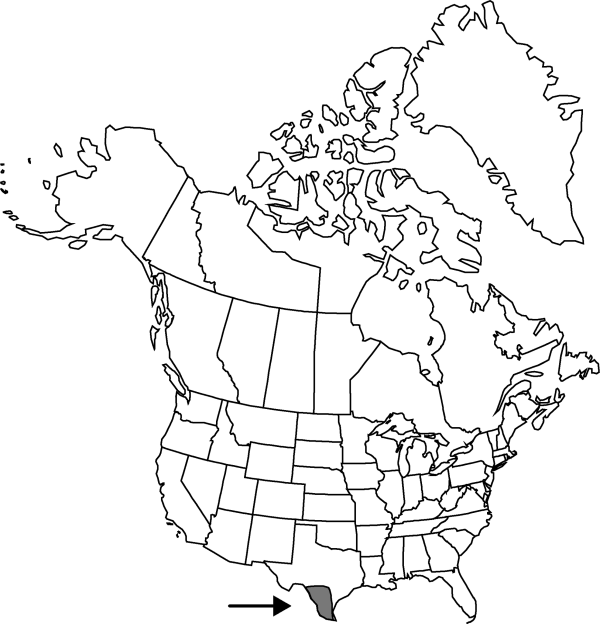Difference between revisions of "Acleisanthes obtusa"
Contr. U.S. Natl. Herb. 12: 371. 1909.
FNA>Volume Importer |
imported>Volume Importer |
||
| (5 intermediate revisions by 2 users not shown) | |||
| Line 8: | Line 8: | ||
}} | }} | ||
|common_names=Berlandier’s trumpets | |common_names=Berlandier’s trumpets | ||
| − | |basionyms={{Treatment/ID/ | + | |basionyms={{Treatment/ID/Basionym |
|name=Nyctaginia obtusa | |name=Nyctaginia obtusa | ||
|authority=Choisy | |authority=Choisy | ||
| + | |rank=species | ||
| + | |publication_title=in A. P. de Candolle and A. L. P. P. de Candolle, Prodr. | ||
| + | |publication_place=13(2): 429. 1849 | ||
}} | }} | ||
|synonyms={{Treatment/ID/Synonym | |synonyms={{Treatment/ID/Synonym | ||
|name=Acleisanthes berlandieri | |name=Acleisanthes berlandieri | ||
|authority=A. Gray | |authority=A. Gray | ||
| + | |rank=species | ||
}} {{Treatment/ID/Synonym | }} {{Treatment/ID/Synonym | ||
|name=Acleisanthes greggii | |name=Acleisanthes greggii | ||
|authority=Standley | |authority=Standley | ||
| + | |rank=species | ||
}} | }} | ||
|hierarchy=Nyctaginaceae;Acleisanthes;Acleisanthes obtusa | |hierarchy=Nyctaginaceae;Acleisanthes;Acleisanthes obtusa | ||
| Line 41: | Line 46: | ||
-->{{#Taxon: | -->{{#Taxon: | ||
name=Acleisanthes obtusa | name=Acleisanthes obtusa | ||
| − | |||
|authority=(Choisy) Standley | |authority=(Choisy) Standley | ||
|rank=species | |rank=species | ||
| Line 56: | Line 60: | ||
|publication year=1909 | |publication year=1909 | ||
|special status= | |special status= | ||
| − | |source xml=https:// | + | |source xml=https://bitbucket.org/aafc-mbb/fna-data-curation/src/2e0870ddd59836b60bcf96646a41e87ea5a5943a/coarse_grained_fna_xml/V4/V4_60.xml |
|genus=Acleisanthes | |genus=Acleisanthes | ||
|species=Acleisanthes obtusa | |species=Acleisanthes obtusa | ||
Latest revision as of 21:59, 5 November 2020
Plants herbaceous, often woody at base, overall pubescence of white, capitate hairs 0.1–0.2 mm. Stems prostrate or spreading, much branched, to more than 100 cm, hirtellous to glabrate. Leaves grayish green, sessile or petiolate, those of pair slightly unequal; petiole to 25 mm, hirtellous to glabrate; blade deltate to deltate-ovate, 2–30(–45) × 2–35(–50) mm, base truncate to subcordate or rounded and short decurrent, margins flat or slightly undulate, apex acute to broadly rounded and often apiculate, puberulent to glabrate. Inflorescences solitary flowers or 2–5-flowered cymes, sessile or with pedicel to 5 mm; bracts linear-subulate, 1–7 mm, puberulent, usually sparsely so. Flowers: chasmogamous perianth 2.5–5.5 cm, sparsely puberulent, tube 1–2 mm diam., limbs 13–25 mm diam., stamens 5; cleistogamous perianth 3–12 mm, puberulent, stamens 5. Fruits 5-ribbed with pair of parallel grooves between ribs, each rib and pair of grooves ending at summit in inconspicuous, glandless knob, oblong, truncate at both ends, often constricted ca. 1 mm above base and below apex, 5–8 mm, hirtellous to sparsely puberulent with capitate hairs and with few, scattered, moniliform hairs 0.2–0.3 mm.
Phenology: Flowering early spring–late fall.
Habitat: Sandy, silty, or clay soils on calcareous or igneous substrates in grasslands, shrublands, or woodlands
Elevation: 0-1800 m
Distribution

Tex., s to c Mexico.
Discussion
Selected References
None.